
(ExxonMobil, 2.Mar.2022) — ExxonMobil detailed plans at its annual Investor Day to deliver industry-leading earnings, cash flow growth and shareholder returns, and lead in the energy transition across a range of lower-emissions scenarios.
“We are focused on leading the industry in safety, reliability, environmental performance, earnings and cash flow growth – and ultimately shareholder returns,” said Darren Woods, chairman and chief executive officer. “We’ll continue to innovate and provide solutions that meet the growing needs of society, including its net-zero emissions ambitions, by fully leveraging our competitive advantages of scale, integration, technology, functional excellence, and our highly skilled people.”
RELATED STORY: NRGBriefs: YPF’s 4Q:21 and FY:21 Webcast; Citgo Sales Process Moving Forward
Company plans include annual structural reductions of $9bn a year by 2023 compared to 2019, building on $5 billion annual structural reductions achieved to date. These savings and other improvements, including a streamlined organizational structure, will enable ExxonMobil to double earnings and cash flow potential by 2027 versus 2019, reduce breakeven costs by roughly $10 per barrel, boost returns on capital employed, and sustainably grow total shareholder returns and distributions.
Full-year 2021 results of $23bn in earnings and $48bn in cash flow from operating activities were the highest among competition and demonstrate how structural improvements, combined with focused investments during the down cycle, positioned the company to realize the full benefit of the economic recovery.
The 2021 results enabled repayment of about $20bn in debt — nearly all of the debt borrowed during the pandemic downturn, the 39th consecutive year of dividend increases, and a $10bn share-repurchase program that started earlier this year.
To improve future earnings, ExxonMobil is upgrading its portfolio with low-cost-of-supply opportunities by investing in advantaged assets, including Guyana and the U.S. Permian Basin. It is also investing in competitively advantaged chemicals and downstream projects, including Gulf Coast Growth Ventures, to grow high-value product sales of performance products and lubricants.
The company expects capital investments of $21-$24bn in 2022 and $20-$25bn per year through 2027. These investments are directed toward low-cost-of-supply Upstream projects in unconventional, deepwater and LNG, and high-value products including chemical performance products, biofuels and lubricants in the new Product Solutions business, which will combine downstream and chemical operations into a single company on April 1.
Spending plans also include more than $15bn over the next six years to reduce greenhouse gas emissions in company operations and for investments in lower-emission business opportunities to help customers reduce emissions and generate attractive returns for shareholders.
“Investment in emission-reduction opportunities will accelerate with advances in technology, market incentives and supportive policy,” said Woods. “We’ve built a portfolio with flexibility to adjust investments between our traditional oil, gas and products business and new lower-emissions opportunities, consistent with the pace and scale of the energy transition, creating long-term value across a broad range of scenarios.”
ExxonMobil established its Low Carbon Solutions business in early 2021 to commercialize its extensive experience in carbon capture and storage, hydrogen and biofuels. Since that time, the company has announced progress on multiple carbon capture and storage opportunities around the world. It also is planning strategic investments in hydrogen, including at its integrated refining and chemical complex in Baytown, Texas, and in lower-emission biofuels at the Strathcona refinery near Edmonton, Canada.
ExxonMobil has stated its ambition to achieve Scope 1 and Scope 2 net zero greenhouse gas emissions for operated assets by 2050, backed by a comprehensive approach to develop detailed emission-reduction roadmaps for major facilities and assets.
The company’s 2030 emission-reduction plans include net-zero emissions for Permian Basin operations by 2030 and a 20-30% reduction in company-wide Scope 1 and Scope 2 greenhouse gas emissions intensity, compared to 2016.
The plans are anticipated to achieve a 40-50% reduction in upstream greenhouse gas intensity, supported by a corporate-wide 70-80% reduction in methane intensity and a 60-70% reduction in flaring intensity. In total, the plans are expected to reduce company-wide absolute greenhouse gas emissions by an estimated 20% and the company’s upstream emissions by 30%. Absolute flaring and methane emissions are expected to decrease by 60% and 70%, respectively. These plans are expected to achieve the goals of the World Bank Zero Routine Flaring by 2030 initiative.
____________________

